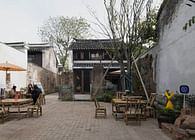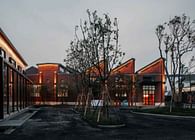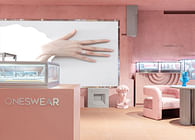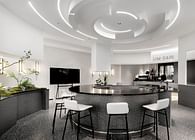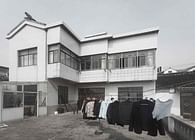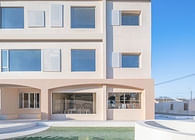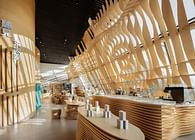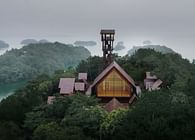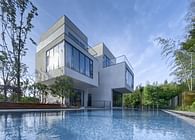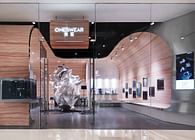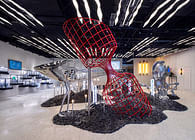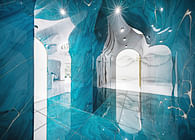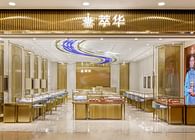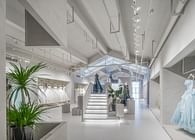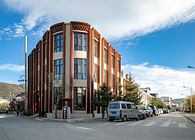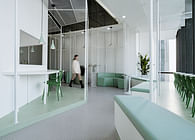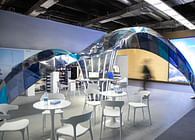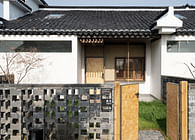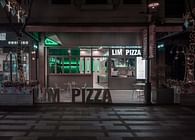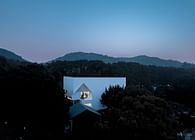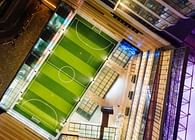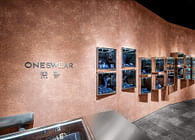
The so-called space intelligence does not refer to the collection of intelligent single products under the control of a single terminal. It refers to technology categories such as integrated wiring, network communication, security protection, automatic control, audio and video, which are to integrate life-related facilities and build efficient management system. It is a higher-level control method based on automation and information technology, which could achieve more complex and diversified communication between people and products, thereby improving the comfort of usage and user-friendly design, facing the future, and displaying the charm of high tech. It is an integrated service system that can meet private customization and any combination.
The project is located on Gala Mall, Lujiazui, Shanghai. As an important part of the urban planning of Lujiazui Binjiang Financial City, the mall is surrounded by financial centre business districts. The store area is about 108 square meters. It is a smart home experience hall. Its brand provides high-tech humanized modern smart home products and smart control strategies.
Based on the positioning of "smart life" and the fundamental demands of product exhibition, we propose the design concept of "module space", and use the "round corner module" as the basic carrier for experiencing the functional space, arranging the spatial blocks with unified form and different functions in a nested way to organize the linear space, so that the functional arrangement is clear and scientific.
The clear visit experience enables the product advantages to be showed efficiently. The soft curved edges, the orderly integration of the module space, and the unified application of material tones also echo the positions of "modular", "integration", "freestyle", "technology" and "the sense of future " which are pursued by the call for "smart life ".
Based on the analysis of the functionality of the space and the usage habits of the crowd, our modularized space has been reorganized: the display window is located on the side of the entrance, giving out an open visual interface to the outside, and forming a relatively private space inside, which will make the brand image area and the guest area reasonably distributed according to the relationship of sights. The exhibition area booths could meet the needs of product display, and at the same time, they are curved lines and are placed in a misplaced position, so that the design could soften the boundaries. To a certain extent, the design also plays a role in limiting space and suggesting spatial dynamics. The "experience zone", the main body of the "shuttle", is reasonably expanded, and the living room with the best visual effect is arranged on the first interface to create a highly visual entrance experience.
Due to the limited space area and the special shape of the plane itself, the model of simulating the real home environment according to the traditional home experience museum can easily cause chaotic function distribution and scale imbalance. In addition, we have considered that there are differences in the home interior style, personality, and aesthetic characteristics among the experiencers, and trying to simulate the design of the real environment is easily counterproductive and creates a sense of strangeness and alienation. Therefore, the layout combines a single home scene with a linear experience streamline, and in accordance with the order of privacy from weak to strong, the living room, kitchen, toilet, and bedroom are arranged from the outside to the inside in order, so that customers could “shuttle” between scene modules. Thereby the characteristics, advantages, and use methods of each product in different scenes could also be reasonably and clearly displayed.
The bar negotiation area is mainly for customers with strong purchase intentions, and is used for in-depth exchange of product information and purchase intentions between customers and shop assistants. The bar counter is placed at the corner of the plane. Under the cover of the shop window, it could create a relatively private space in the store.
The ground level of the scene experience area is raised by two steps to build a sense of realm and entering ceremony. The display units are separated by electronically controlled glass, so shop assistants could demonstrate the integrated linkage effect of the full set of products to customers through the function control panel in the living room.
In order to reflect the sense of future technology in the space, and at the same time to highlight the product, in the overall material selection, the use of mixed oil wood finishes and epoxy floor paint creates a pure white space tone. The arc surfaces of the wall connections between the floors and the walls and the ceilings are made of galvanized square pipes to build the shape skeleton. The floor paint is digitally adjusted to achieve a colorless connection with the wall surface, providing participants with a sense of future high tech and an integrated feeling of indoor floor, ceiling and wall. This design will not be overwhelming, but will put stress fully on the product so as to maximize its characteristics.
In addition to traditional spotlights and downlights, the space lighting part uses a large number of rounded shape lamps and light strips. The shape echoes the arc elements used in the space, which emphasizes the space elements to a certain extent and weakens the sense of big volume and the turning relationship of the furniture. The large-area white space tone combined with the strong point-to-line-to-face contrast between the point-like lighting and the light strip, the different degrees of reflection on the glass and the wall show the charm of intriguing dynamic details.
From the shape of the interface of the module space to the edge of the booth, the shape of the information wall, and the shape of the lamps, the whole has been processed into an arc, softening the sense of distance and coldness of the technology, making the smart home presentation more friendly and natural. In order to emphasize the curvilinear shape, the marble veneer is used on the wall at the junction of the edges. The stone texture emphasizes the home attributes, adding a heavy color to the space, enriching the sense of layering, and preventing the pure white space environment from being overly indifferent.
Status: Built
Location: Shanghai, CN
Additional Credits: Partners: Suzhou Re-design Studio
Photo credits: Jieqi Yao








